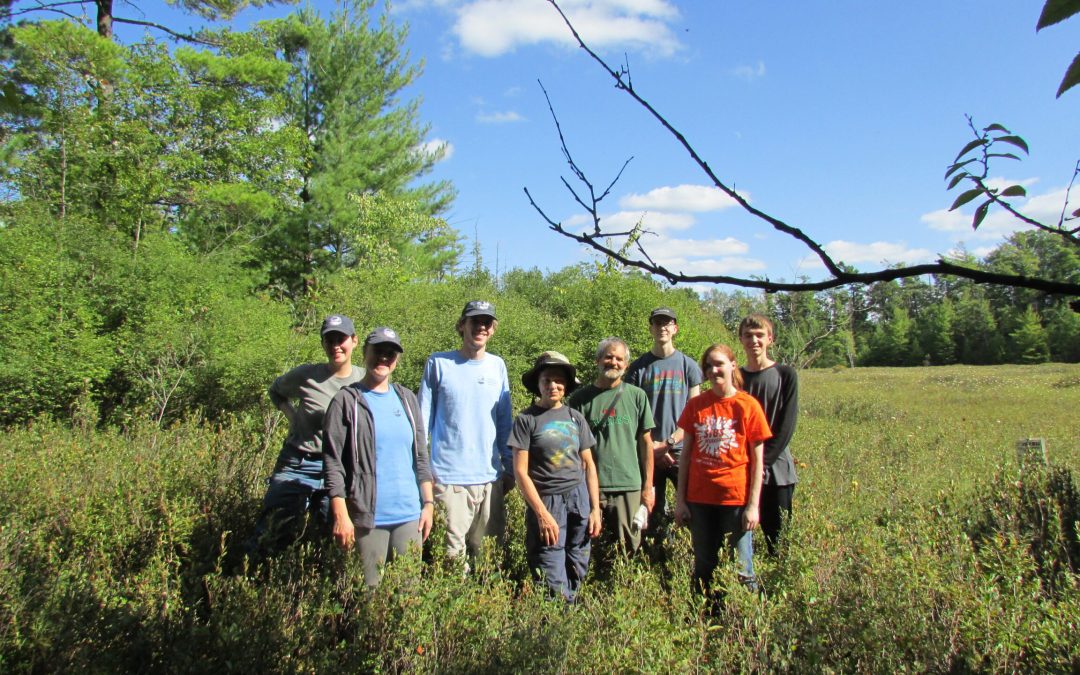Part of WNY PRISM’s mission is to address invasive species priorities throughout western New York. To do this we work with partner organizations who alert us to invasive species threats on their properties. One such partner is the Nature Sanctuary Society of Western New York (NSSWNY), which protects properties throughout the region to promote plant and animal preservation. The NSSWNY enlisted our help to manage a population of invasive glossy buckthorn (Frangula alnus) found in Houghton Preserve in Erie County.
Houghton Preserve, previously known as the East Concord Bog, was the first property purchased by the NSSWNY. The 23-acre preserve contains a kettlehole bog, a rare type of wetland that lacks surface water inflows and outflows, but instead is fed by groundwater and precipitation. The bog is comprised of peat (partially decomposed plant material) topped with a layer of Sphagnum moss and a host of unique native plants that thrive in acidic (low-pH) environments like leatherleaf (Chamaedaphne calyculata) and cranberry (Vaccinium macrocarpon). Carnivorous plants which include pitcher plants (Sarracenia spp.) and sundews (Drosera spp.), add to an otherworldly feel.

The bog is surrounded by a forested wetland that contains a range of native species that include eastern hemlock (Tsuga canadensis), bur-reed (Sparganium spp.) and white turtlehead (Chelone glabra). Unfortunately, this area of the preserve is also where the glossy buckthorn invasion was documented.
Glossy buckthorn is a small tree or shrub native to Asia, North Africa, and parts of Europe that can be identified by its leaves, that are shiny and alternate with complete margins. Its bark is also easily identifiable as dark grey to brown with white lenticels. This species is an invasive threat because it produces a large amount of seed, which allows it to spread rapidly and displace native species. In order to stop the expansion of the population in the Houghton Preserve, WNY PRISM and the NSSWNY managed much of the population this summer.


Glossy buckthorn has several distinguishing characteristics including its lenticel-covered bark and shiny, alternate leaves. Photo Credit: Leslie J. Mehrhoff, www.bugwood.org.
On September 5 and 6 the WNY PRISM Crew (Crew) and a group of volunteers set out to remove and treat the glossy buckthorn in the preserve. Because this infestation was detected early in its development, the vast majority of plants were seedlings and were easily removed by hand. Larger plants we found were cut with hand clippers, loppers or saws and the Crew treated the stumps with a small drop of herbicide to prevent the plants from resprouting.

The Crew and the NSSWNY President also surveyed other areas of the preserve for additional glossy buckthorn populations and other invasive species. During the survey, several glossy buckthorn populations, multiflora rose (Rosa multiflora) and bush honeysuckle (Lonicera spp.) were discovered. The latter two invasives were not present in large numbers and the NSSWNY hopes to control these in the future.
The Crew and volunteers were able to appreciate the native plant and animal communities during this survey. Among other things they saw a painted turtle (Chrysemys picta) and Canada yew (Taxus canadensis). The rich biodiversity of Houghton Preserve is under threat of invasive shrubs, but the work done by WNY PRISM and the NSSWNY can help to mitigate this threat and maintain biodiversity for years to come.
This article was written by Ryan Elliott, 2019 Invasive Species Management Assistant.


